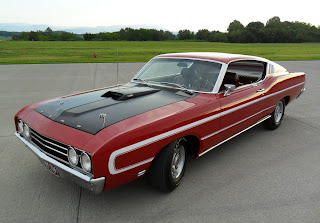Officially, these are known simply as Cobras, according to period Ford advertising and sales brochures, and more importantly, the dealer winder-sticker. Really though, these are Fairlanes, as the Torino designation was an option package for the Fairlane body-code and was not yet a separate model line in 1969. Sometimes also referred to as the Torino GT or Fairlane Cobra, this naming convention generates some debate in collector circles. This line featured two body styles: the hardtop (aka “formal roof”) and the much more common “sports roof” fastback. The Cobra performance package included as standard the 335 hp 428 Cobra Jet V-8 with a Holly 4bbl. Optional Ram Air didn’t increase horsepower, but it boosted the performance peak to 5,600 rpm. Also included was a locking rear differential, which was exclusive to Ford. Quarter mile times were typically in the 14.5 second range. Exact production figures are difficult to come by, but it is estimated that about 14,000 Cobras were sold in 1969, with the vast majority of them being the fastback version. Naturally, I prefer the rare hardtop (pictured here), which number about 3,000.
The Ford Fairlane was an automobile model sold between 1955 and 1970 by the Ford Motor Company in North America. The name was taken from Henry Ford's estate, Fair Lane, near Dearborn, Michigan.
Over time, the name referred to a number of different cars in different classes; the Fairlane was initially a full-size car, but became a mid-size car from the 1962 model year. The mid-sized model spawned the Australian-built Fairlane in 1967, although it was considered a large car there listverse.com
The Cobra was introduced in 1969 as a competitor for Plymouth's Road Runner. Basic models featured the 302 CID V8 and three-speed manual transmission as standard. Options included the 390 CID and two 428 CID V8s. The Cobras, meanwhile, had a standard 428 CID V8 with 335 bhp (250 kW), and options included bucket seats, hood scoop, clock, tachometer, power disc brakes and 4.30:1 rear axle gearing. "Regular" Fairlanes and Rancheros continued, all with bucket-seat options.
An even more powerful version, the Torino Talladega, was created to compete on the NASCAR Grand National speedways. Only 754 were built. To compete with the new Dodge Charger 500, the Sportsroof-based Ford Torino Talladega got a sloped nose and flush grille. The 428 CID V8 was standard, but it was mated to a C-6 Cruise-o-Matic automatic transmission.
Ford Torino Talladega
The Ford Torino Talladega was a car produced by the Ford Motor Company during the first few weeks of 1969, only. Ford's Talladega was named after the Talladega Superspeedway racetrack in Alabama, which also made its debut in 1969. The Ford Talladega was a special, more aerodynamic version of the Ford Torino / Fairlane Cobra. It was produced specifically to make Ford even more competitive in NASCAR stock car racing, and it was sold to the public only because homologation rules required a certain minimum number of cars (500 in 1969) be produced and made available for sale to the public. It is believed that a total of 754 Talladegas may have been built, although the Talladega/Spoiler Registry can only account for a maximum of 750.
This number includes all prototypes, pilot cars, and production cars built, plus a special post-production car that was built for the president of Ford Motor Company, Semon Emil "Bunkie" Knudsen, in March 1969. The Bunkie Knudsen car was significantly different from all of the homologation cars with regard to options and color. This Talladega was even built at a different plant: Ford's Lorain, OH plant on March 20, 1969. However, all production examples were constructed during January and February 1969 at Ford's Atlanta, Georgia plant.
All production homologation cars produced after the pilot cars were built between January 21 and February 28. (According to the Talladega/Spoiler Registry's records, Talladega number 502 was actually completed on January 31, and then the last 247 homologation cars were built between February 14 and February 28, following a 2 week break in production.) It is unknown as to why Ford built an "extra" 247 homologation cars, once the homologation requirements had been met during the initial run, as it is thought that Ford lost several thousand dollars on every Talladega that was built. wikipedia.org














No comments:
Post a Comment